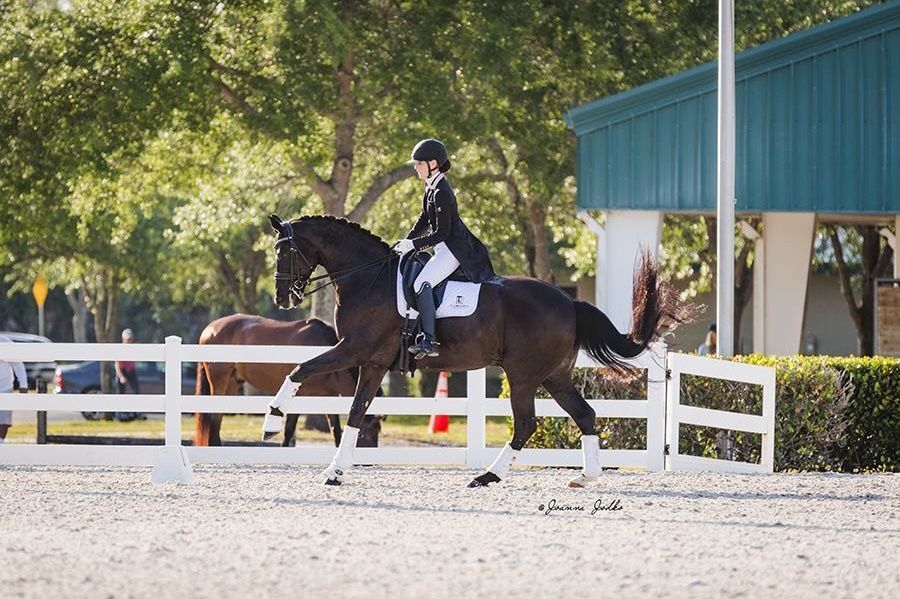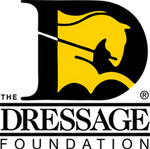
Photo by Joanna Jodko
Recipient: Katie Bogaert
Training Location: Wellington, Florida
Trainers: Sarah and Lee Tubman of Tubman Dressage Horses
Ridden:
- Cedric: Dutch gelding by Lord Leatherdale
- Furst Fritz: Oldenburg gelding by Furst Romancier
Training Overview
I had the incredible opportunity to train in Wellington, Florida, under the guidance of Sarah and Lee Tubman at Tubman Dressage. During my time there, I worked with two horses five days a week:
- Cedric: We focused on schooling Prix St. Georges (PSG) with aspirations toward Intermediate I (I1).
- Furst Fritz: As my new partner, we aimed for showing PSG and I1, with the goal of competing in a CDI, which would be my first CDI!
In addition to these two, I rode a sales horse five days a week, gaining valuable experience as a professional in representing horses to prospective buyers. Sarah and Lee were helpful in guiding me during this process

Photo by Joanna Jodko
Key Takeaways
Training with two very different horses each day was both challenging and educational. It enhanced my ability to develop feel and understanding across horses with different personalities and training needs.
The Importance of Basics
The general theme of most of my lessons was a deeper understanding of "the basics" in dressage. Most any professional will agree the basics are the most important part of dressage training, but oftentimes “the basics” is a very general term. Sarah and Lee helped me break down what this truly entails, and here are some of the key takeaways from my training:
- Transitions: Smooth, responsive, supple, and in self-carriage.
- Half Halts: The horse should be responsive and accepting, with noticeable improvement after the half halt.
- Suppleness: The horse should be even in both reins and equal on both sides of its body.
- Contact: Correct contact comes from the correctness of the hind-end engagement.
Exercises to Improve Basics
- Walk-Halt Transitions: Although simple in thought, they can be complex in execution. Key questions to consider:
- Was the transition responsive and smooth?
- Does the horse maintain acceptance of the contact in the halt?
- Is the horse attentive through the transition?
- Trot-Walk-Trot Transitions: These transitions test the same basics and add layers of complexity, strengthening half-halts, hind engagement, suppleness, and responsiveness. Like the Walk-Halt Transitions, they are simple in thought but can really test your basics! - (I mean you should be able to trot, walk two steps, then trot again without any trouble, right?!)
Lateral Work with Transitions
Transitions within lateral work are another effective exercise that tests the basics. For example:
- Leg yielding from the quarter line to the rail with walk and trot transitions
- Shoulder-in with walk and trot transitions
- Canter half-pass with walk and canter transitions
These exercises expose underlying issues and challenge the horse's responsiveness and suppleness.

Warm-Up Strategies
Before my time with the Tubmans, I might have referred to the warm-up as a "routine." However, I learned that a warm-up should be a "strategy," tailored to each horse's needs. "Routine" implies that it is premeditated and that is not what our horses need from us. A good outlook on the warm-up section of your ride could be referred to as a warm-up "strategy". The simple change in words is helpful as you develop what a good strategy is. Not all horses require the same warm-up, and your strategy is dependent on the horse's needs. The strategy you use won't stray far from the basics but will vary from horse to horse. My strategies varied for Cedric and Fritz:
- Cedric: Included lateral work and transitions within the lateral work to enhance suppleness and self-carriage.
- Fritz: Focused on frequent transitions to create higher responsiveness and engagement.
Conclusion & Gratitude
I am immensely grateful to The Dressage Foundation and the donors for this opportunity! The knowledge and skills I gained from Sarah and Lee Tubman are not only enhancing my own riding but also benefiting my students at home. I am excited to share these insights and continue developing as a dressage instructor and rider.
Thank you once again for supporting my journey and contributing to my growth in the sport of dressage!

